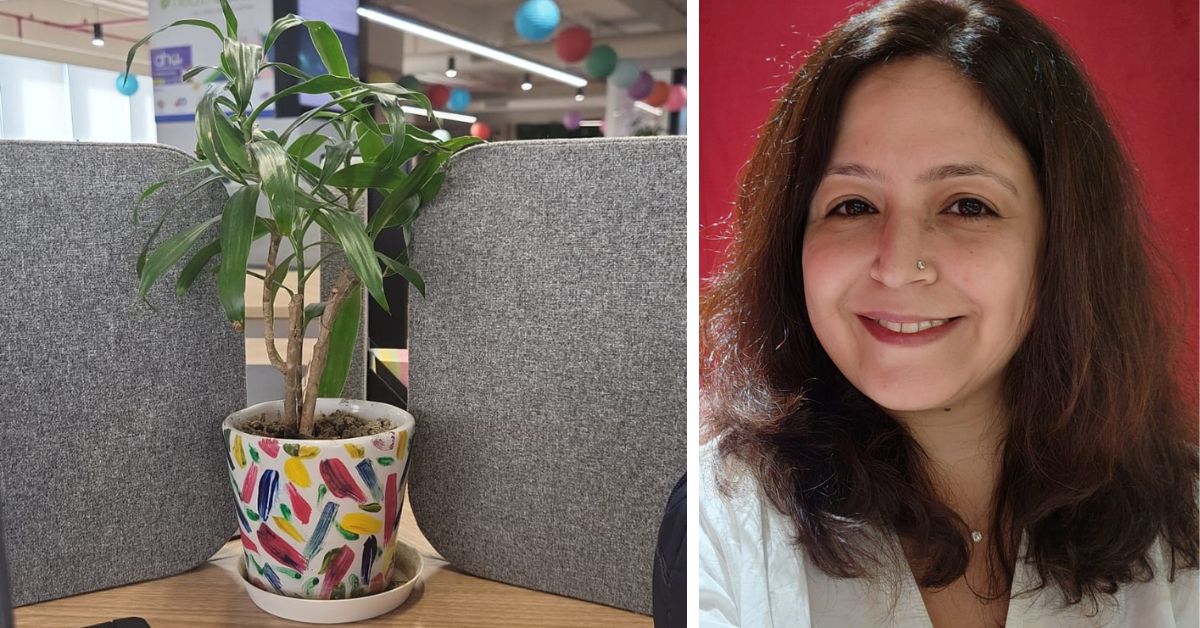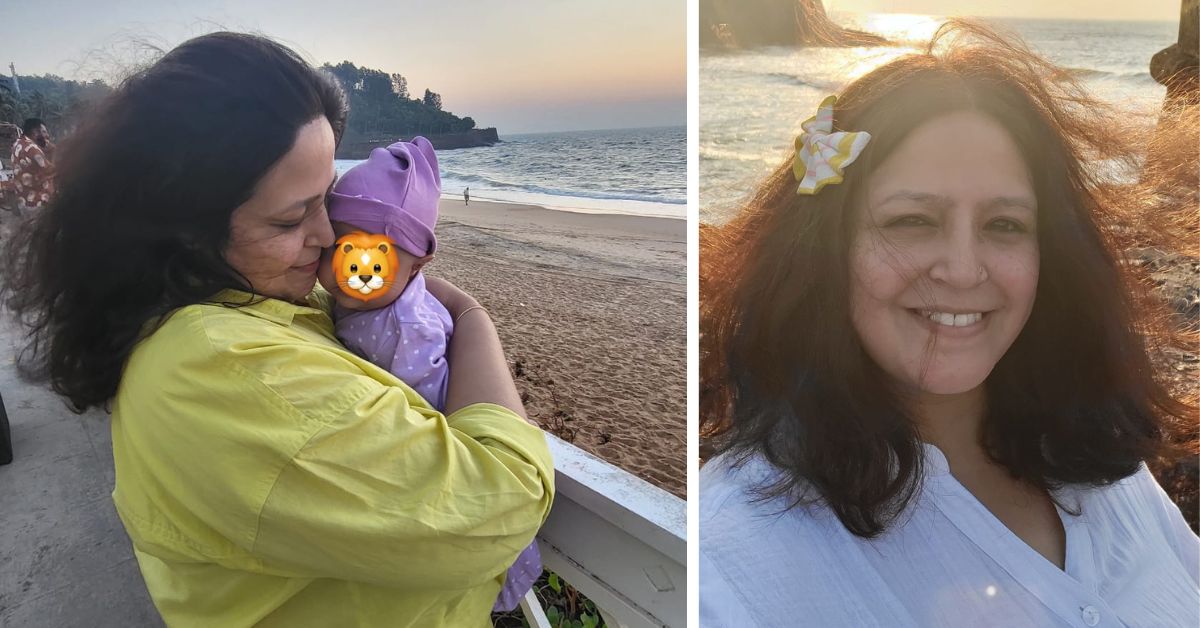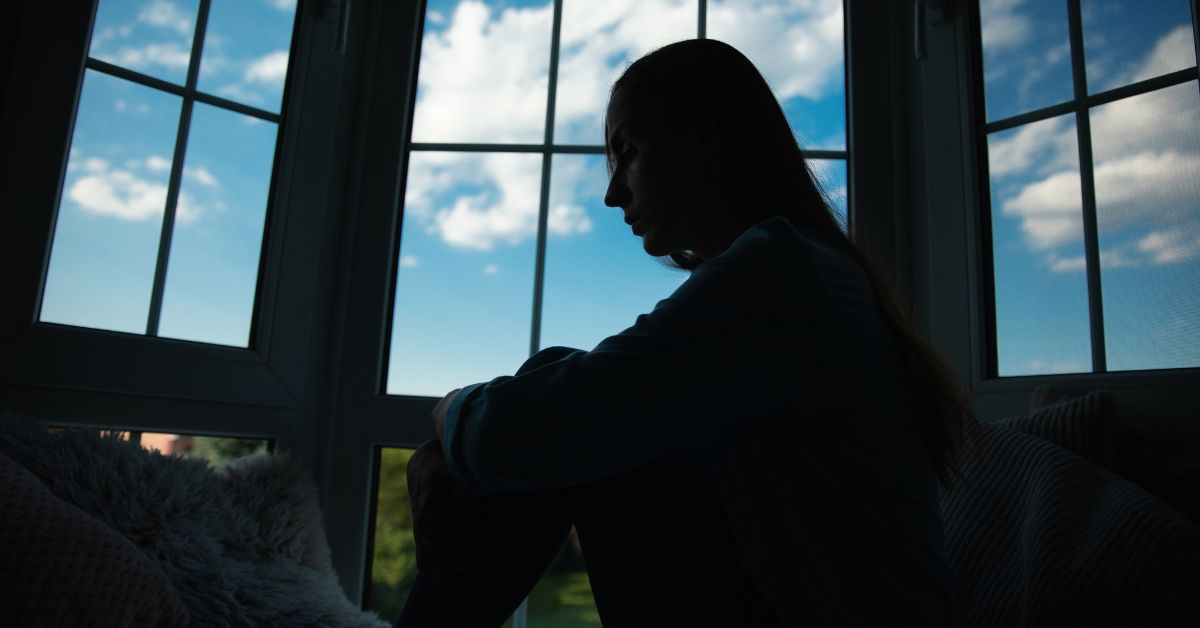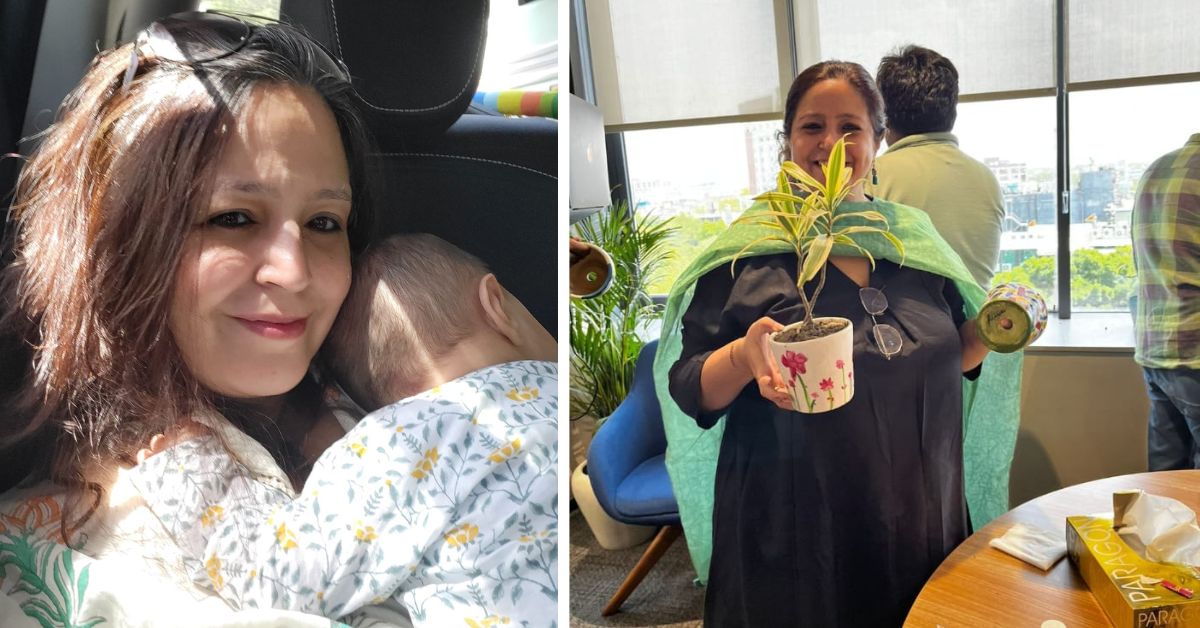After 3 Miscarriages, This Journalist Finally Became a Mom — A Story So Many Women Will Relate To
Propped on the desk at Radhika Bhirani’s workspace is a pretty pot, its terracotta exterior hugged by a vivid flower design. Despite her penchant for all things artsy, Radhika is biased towards this particular piece of décor; the bond they share is allegorical.
The pot, you see, is a metaphor for hope.
On 22 April 2024, Radhika, in her first trimester of pregnancy, was attempting a design on the pot for a World Earth Day competition at work.
And then she felt it. A trickle on her underwear.
“A loo break later, all hell broke loose in my head,” she recalls the torrent of what-ifs that exploded in her mind. “I had tears; my hands were shivering.” The genesis of this paranoia lay in the three miscarriages she’d had over the past decade. The bleeding, the shock that followed in the aftermath of it, and the trauma of being told she had lost her baby were scarily familiar feelings.
In the moment that she felt that trickle of blood, a terrible déjà vu had crept up on her; it kept her company all through the ride to the doctor, the tests — the ultrasound revealed that she was experiencing a subchorionic haemorrhage (bleeding between the uterine wall and the baby’s amniotic sac), and the advised month-long bedrest.
 Radhika Bhirani (R) and the pot that she painted for the World Earth Day competition
Radhika Bhirani (R) and the pot that she painted for the World Earth Day competition
While Radhika did carry to term, delivering a healthy baby, she couldn’t shake off the anxiety that would tug at her relentlessly during the remaining two trimesters, until it got her attention. It always had the same question for her: What if we miscarry again?
What if it doesn’t work out? It would follow up.
What if it does? She’d counter-question it.
Perhaps the reason why Radhika loves the pot is that it is a reminder of the quiet power of believing she can brave any storm.
Grief doesn’t wear a single label
There are over 6,00,000 words in the Oxford Dictionary. Radhika, a journalist whose work hinges on articulating things perfectly, can’t find the right one to describe the feeling of holding her infant for the first time. How do you verbalise a moment that has been a lifetime in the making? How do you describe the cataclysmic love your heart feels when, after loss upon loss, you hold joy in your arms?
“There is no feeling that matches it,” Radhika adds.
“After a delivery, you’re surrounded by people, and so rarely do your raw emotions come out. But when everybody retires for the day and the husband, baby, and the mother are in the room alone, you have that first moment of shared joy; you release all the grief that you’ve accumulated all these years.”
Acknowledging that pregnancy is a testing time for relationships, she shares, “When you hold the child together, you realise why they say a child will make you stronger together than ever before. And I think that is something we [my husband and I] experienced when we held our baby for the first time.”
 After three miscarriages, Radhika Bhirani became a mother to a beautiful baby
After three miscarriages, Radhika Bhirani became a mother to a beautiful baby
I was reading an article in The New York Times about childbirth after a miscarriage. Sadness and joy live beside each other. One particular phrase stuck with me: “You cannot fast forward through grief to get to the other side.”
The article equated grief to a gnawing abyss.
Do abysses — in the real sense — have a way out, I wondered. A quick Google search revealed that the only plausible way of emerging from an abyss was a “physical ascent that requires a great deal of strength, skill, and patience.”
You just have to keep going.
Radhika would know better. She has powered through an abyss of her own, choosing hope even after multiple miscarriages.
“The babies I lost in early miscarriages were as important as the baby I have right now. Those feelings never go; the hollowness never leaves; it carves a hole in your heart. I haven’t forgotten what I faced, but it made me mentally vulnerable and stronger at the same time.”
While all three miscarriages were in the nascent stages of foetal development — prior to detecting the heartbeat — she reasons that loss is loss.
“The thing about pregnancy is that the moment you see the sac, there is an instant connection. There are so many emotions that a woman starts to attach, so many dreams that she starts seeing. When those dreams come crashing down, it just shakes you up internally.”
Each miscarriage brought with it the tacit acceptance that she just had to resign herself to fate.
By the third loss, she questioned why it was conspiring against her. With every loss, she mourned both what was and the hope in what could have been.
Pregnancy and loss: the ambiguities and emotional binaries
Over a call, Radhika recounts the most harrowing moments of her failed pregnancies. There are moments when I gauge her voice wavering, as she plucks these painful memories from the depths of her mind’s archives. I suggest we take a break.
“Let’s keep going,” she tells me. Radhika’s voice may waver, but her mental fortitude doesn’t. She hopes her story will encourage women to start opening up about their lived experiences during pregnancy, especially about pregnancy loss. “We are conditioned in such a way that we don’t talk about these experiences. My story has found resonance among people.”
Every pregnant woman, or even every woman who is trying to get pregnant, she discovered, fights a battle — sometimes shaped by destiny, sometimes by circumstance.
A health writer, Radhika, often found herself conversing with the women in the waiting area of the gynaecologist’s clinic. These dialogues taught her how ignorance is a symptom of the societal connotations around infertility.
A study in the National Library of Medicine agrees. “Despite the fact that infertility affects both men and women fairly equally, in many societies, the woman is most often blamed when she does not get pregnant, resulting in mental health distress, stigma, discrimination, social exclusion, and abandonment,” it reads.
 Infertility is often seen as the woman’s fault leading to stigma, discrimination, social exclusion, and abandonment
Infertility is often seen as the woman’s fault leading to stigma, discrimination, social exclusion, and abandonment
This same idea was underscored by Dr Asha Pawaiya, a gynaecologist with over two decades of experience, who was quoted sharing with Earth Journalism Network, “In such a situation [infertility] the woman is the first one to be blamed and she is subjected to familial and social abuse every now and then, as well as threats of abandonment.”
Her brief interactions with the expectant mothers at the gynaecologist gave Radhika a front row seat to how multifaceted every woman’s struggle is. “Somebody’s facing thyroid issues, someone else has diabetes, someone has blood pressure problems — there are so many stories, and not everybody gets that support.”
This is exactly why, Radhika points out, you need to choose your gynaecologist carefully. “It’s important to clear myths. Ask the right questions that will help you know your body better, you need to have that autonomy.”
It’s a well-known fact that raising a baby takes a village. Well, having one takes many.
“How many women do you think can go up to their bosses and say, ‘I think I’m suffering a miscarriage and I need to head to the hospital.”? Creating that safe space is crucial; having support puts your mind at ease.”
She adds, “I have been extremely lucky to have both sets of parents, who have never pressured me into having a child. Instead, they have been my motivation through it all.” She credits her husband, who stayed stoic through it all.
Tiptoeing around happiness
Cautiously happy — a term that resonated throughout Radhika’s pregnancy.
After having the joy of motherhood wrestled from her thrice, naturally, she was sceptical the fourth time around. “Being cautiously happy became our acquired philosophy of life. When we announced this pregnancy, the immediate reaction from people was ‘oh wow, you guys must be on top of the world’, and my husband would reply that we, as a couple, were being cautiously happy. It became our joint mantra to deal with what was to come after what we had endured.”
She didn’t want to get complacent with luck. “So many expecting mothers who face miscarriage, infertility, and high-risk pregnancies feel joy when they get pregnant. But they also end up being very protective of this happiness.” This prudent manoeuvring around happiness became palpable during moments like planning a baby shower. “Should we? Should we not? Should we celebrate? When should we break the news to people? Should we start getting the nursery ready? Should we buy things for the baby?”
Every decision was a conundrum.
Did Radhika lean into the side of hope or not?
She soon figured, hope is a capricious dynamic.
“Not every day was the same. You can only hold on to hope and faith, and believe that things will be okay, but there are moments when you doubt it. There was major coexistence of joy and fear in my life at that point, because we never knew what the next stage would hold. At every stage, there were so many fears we dealt with. We would often wonder whether the next ultrasound would be fine or reveal something.”
Radhika’s fear was realised when, after one particular 20-week ultrasound, the doctor informed her that the foetus had a short nasal bone, which could be suggestive of Down’s Syndrome. “Should the test come positive, I was recommended not to proceed with the pregnancy.”
The test was negative.
Anxiety revisited her once more when she was diagnosed with gestational diabetes. “My levels were impossible. So from a person who feared needles, I became someone who would prick myself multiple times every day.” The diabetes also necessitated a complete overhaul of her diet. “I had to control my portions, control my rice intake, carbohydrate intake, and increase my protein intake. I couldn’t have sugar in my tea, no biscuits, no bread, all of the things I love, so that was also mentally charging me up in many ways.”
At every bend in the road, her faith was tested.
 Radhika Bhirani hopes her story will be a source of comfort for women who deal with pregnancy loss
Radhika Bhirani hopes her story will be a source of comfort for women who deal with pregnancy loss
Today, a beautiful mother to a beautiful baby, her learnings converge on a single truth — “The road to motherhood is uneven, as is the experience of motherhood. For a lot of people, it takes adapting; it takes effort to recognise that people will always ask about the child before the woman.”
But even as Radhika has underlined the profundities of experiencing joy following loss, she says it isn’t as easy.
“Every couple deals with the loss differently. A miscarriage has a mental, physical, emotional, psychological, and physiological impact.”
Through her story, she hopes that women start talking about their experiences.
“If there is a woman out there scrolling her Instagram or LinkedIn, and feeling comforted knowing that they’re not alone, that they can draw strength from my story, that is enough.”
Propped on the desk at Radhika Bhirani’s workspace is a pretty pot. On days when her grief gets heavy, she can swear those painted colours seem to shine brighter.
Edited by Khushi Arora; All pictures courtesy Radhika Bhirani
News